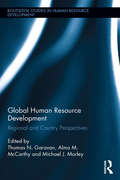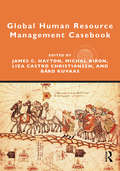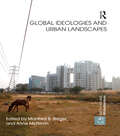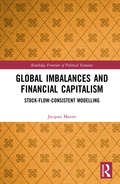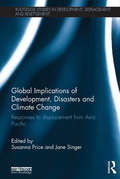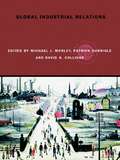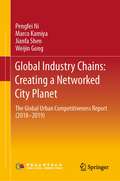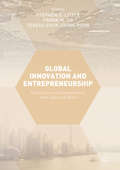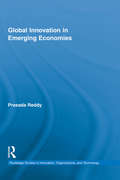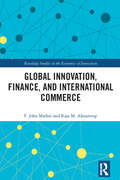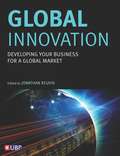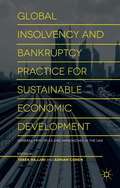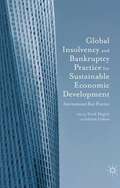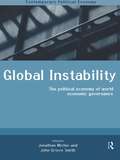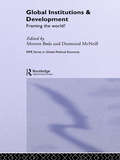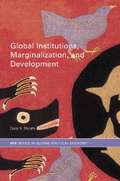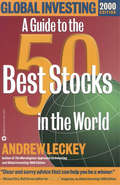- Table View
- List View
Global Human Resource Development: Regional and Country Perspectives (Routledge Studies in Human Resource Development)
by Michael J. Morley Thomas N. Garavan Alma M. McCarthyDrawing on contributions from leading academics in the field, this volume within the Routledge Series in Human Resource Development specifically focuses on Global Human Resource Development (HRD). Specifically, the volume provides an overview of 17 regions, 85 countries and includes one emerging market grouping, CIVETS. This book examines the role of the state in HRD, the relationship between HRD and the level of economic development in the country or region, the influence of foreign direct investment within the country or region, and firm-level HRD practices within countries or regions. Global Human Resource Development analyzes HRD from institutional and cross-cultural perspectives, making it possible, for the first time, to analyze trends across countries and regions and to draw conclusions about the value of institutional and cross-cultural perspectives in the HRD context. There is currently no book on the market that conceptualizes the discipline of global HRD in this way, making this a definitive book on HRD across the globe of particular interest to researchers and reflective practitioners.
Global Human Resource Management Casebook
by James HaytonThe Global Human Resource Management Casebook is a collection of business teaching cases, focusing on Human Resource Management issues around the world. Each case is based in a single country and illustrates one or more significant challenge faced by managers and HR practitioners. The influence of the unique national cultural and institutional context upon the issues in the case is emphasized. In total 32 unique and original cases are presented, each from different national contexts. Every case is followed by a set of questions for use in class discussion or private study of the cases. This casebook is a project undertaken by a committee of international members of the Human Resources Division of the Academy of Management (USA). The HR Division currently has over 3500 members worldwide, indicating a significant immediate audience for the text. The committee, referred to as the HR Ambassadors Committee (James Hayton, Chair) is intended to represent the global membership of the organization. We currently have members in over 60 countries, and Ambassadors for over 50 of these. The committee was established to contribute to the internationalization of the HR Division and the Academy of Management by creating collaborative projects that both involve and serve the global membership. This book, which represents the first product of our collaboration, is expected to provide a useful teaching tool for HRM educators, and secondarily is expected to be of use to HR practitioners with an interest in the globalization of HRM.
Global Ideologies and Urban Landscapes (ISSN #1)
by Manfred B. Steger Anne McNevinHow do political ideologies and urban landscapes intersect in the context of globalization? This volume illuminates the production of ideologies as both discursive and spatial phenomena in distinct contributions that ground their analysis in cities of the Global North and South. From Sydney to Singapore, Hong Kong to Hanoi, Las Vegas to Macau, conventional public spaces are in decline as sites of ideological dissent. Instead, we are witnessing the colonisation of urban space by market globalism (today’s dominant global ideology) and securitised surveillance regimes. Against this backdrop, how should we interpret the proliferation of metaphors that claim to communicate the essence of global transformation? In what ways do space and language work together to normalise the truth claims of powerful ideological players? What kinds of social forces mobilise to contest the cooptation of language and space and to pose alternative local and global futures?This volume poses these questions against the collapse of old geographical scales and cartographic techniques for identifying the contours of civil society. The city acts as an entry point to a new spatial analytics of contemporary ideological forces.This book was published as a special issue of Globalizations.
Global Imbalances and Financial Capitalism: Stock-Flow-Consistent Modelling (Routledge Frontiers of Political Economy)
by Jacques MazierThe past few decades have witnessed the emergence of economic imbalances at the world level and within the euro zone. The failure of mainstream economics to accurately predict financial crises, or model the effects of finance-led growth, highlights the need for alternative frameworks. A key text, Global Imbalances and Financial Capitalism: Stock-Flow-Consistent Modelling demonstrates that Stock-Flow-Consistent models are well adapted to study this growth regime due to their ability to analyse the real and financial sides of the economy in an integrated way. This approach is combined with an analysis of exchange rate misalignments using the Fundamental Equilibrium Exchange Rate (FEER) methodology, which serves to give a synthetic view of international imbalances. Together, these models describe how global and regional imbalances are created, as well as suggest appropriate tools through which they may be reduced. The book also considers alternative economic policies in the euro zone (international risk sharing, fiscal federalism, eurobonds, European investments, a multispeed euro zone) alongside alternative monetary policies. In particular, it examines the possibilities of using SDR (Special Drawing Rights) as a reserve asset to be issued to fight a global recession, to support the development of low-income countries, or as an anchor to improve global monetary stability. This text will be of interest to students, scholars, and researchers of economic theory and international monetary economics. It will also appeal to professional organisations who supervise international relations.
Global Imbalances and Petrodollars
by Fuad Hasanov Rabah ArezkiA report from the International Monetary Fund.
Global Imbalances and the Lessons of Bretton Woods (Cairoli Lectures)
by Barry EichengreenWhy the current Bretton Woods-like international financial system, featuring large current account deficits in the center country, the United States, and massive reserve accumulation by the periphery, is not sustainable. In Global Imbalances and the Lessons of Bretton Woods, Barry Eichengreen takes issue with the argument that today's international financial system is largely analogous to the Bretton Woods System of the period 1958 to 1973. Then, as now, it has been argued, the United States ran balance of payment deficits, provided international reserves to other countries, and acted as export market of last resort for the rest of the world. Then, as now, the story continues, other countries were reluctant to revalue their currencies for fear of seeing their export-led growth slow and suffering capital losses on their foreign reserves. Eichengreen argues in response that the power of historical analogy lies not just in finding parallels but in highlighting differences, and he finds important differences in the structure of the world economy today. Such differences, he concludes, mean that the current constellation of exchange rates and payments imbalances is unlikely to last as long as the original Bretton Woods System. Two of the most salient differences are the twin deficits and low savings rate of the United States, which do not augur well for the sustainability of the country's international position. Such differences, he concludes, mean that the current constellation of exchange rates and payments imbalances is unlikely to last as long as the original Bretton Woods System. After identifying these differences, Eichengreen looks in detail at the Gold Pool, the mechanism through which European central banks sought to support the dollar in the 1960s. He shows that the Pool was fragile and short lived, which does not bode well for collective efforts on the part of Asian central banks to restrain reserve diversification and support the dollar today. He studies Japan's exit from its dollar peg in 1971, drawing lessons for China's transition to greater exchange rate flexibility. And he considers the history of reserve currency competition, asking if it has lessons for whether the dollar is destined to lose its standing as preeminent international currency to the euro or even the Chinese renminbi.
Global Implications of Development, Disasters and Climate Change: Responses to Displacement from Asia Pacific (Routledge Studies in Development, Displacement and Resettlement)
by Susanna Price Jane SingerDisplacements in the Asia Pacific region are escalating. The region has for decades experienced more than half of the world’s natural disasters and, in recent years, a disproportionately high share of extreme weather-related disasters, which displaced 19 million people in 2013 alone. This volume offers an innovative and thought-provoking Asia-Pacific perspective on an intensifying global problem: the forced displacement of people from their land, homes, and livelihoods due to development, disasters and environmental change. This book draws together theoretical and multidisciplinary perspectives with diverse case studies from around the region – including China’s Three Gorges Reservoir, Japan’s Fukushima disaster, and the Pacific’s Banaba resettlement. Focusing on responses to displacement in the context of power asymmetries and questions of the public interest, the book highlights shared experiences of displacement, seeking new approaches and solutions that have potential global application. This book shows how displaced peoples respond to interlinked impacts that unravel their social fabric and productive bases, whether through sporadic protest, organised campaigns, empowered mobility or; even community-based negotiation of resettlement solutions. . The volume will be of great interest to researchers and postgraduate students in development studies, environmental and climate change studies, anthropology, sociology, human geography, international law and human rights.
Global Industrial Relations (Global HRM)
by David G. Collings Michael J. Morley Patrick GunnigleBreaking new ground and drawing on contributions from the leading academics in the field, this notable volume focuses specifically on industrial relations. Informative and revealing, the text provides an overview of the industrial relations systems of nine regions (North America, South America, Western Europe, Eastern Europe, the Middle East, Australia and New Zealand, Asia, Africa, and India) and is divided into two distinct sections covering: regional variations in global industrial relations systems contemporary themes in global industrial relations. Combining both systems and thematic issues, this important new text is invaluable reading for postgraduates and professionals in the fields of human resources management, industrial relations and business and management as well as anyone studying or interested in the issues surrounding global industrial relations.
Global Industry Chains: The Global Urban Competitiveness Report (2018–2019)
by Pengfei Ni Jianfa Shen Marco Kamiya Weijin GongThis report presents the outcomes of a survey project of the National Academy of Economic Strategy of the Chinese Academy of Social Sciences and the United Nations Human Settlements Programme. The project evaluated and ranked the competitiveness of 1,007 global cities, with a combined population of over 500,000, based on a number of selected indicators. The report provides an overview of the global urbanization pattern and areas of improvements in the selected cities. The outcomes of the project confirm that the formation and changes of global value chains have caused profound changes in economic structures in some countries and affected the development of cities in these countries, thereby reshaping the city planet.In addition to comparative analysis of competitiveness of cities, this report also sheds light on the global pattern and trends of economic and human development. It reveals four new findings regarding the development of cities around the world: First, over the past four decades, human societies are transitioning quickly from agricultural societies which are characterized by scattered settlements to industrial societies which are characterized by city clusters, interconnectivity, and resource sharing. The planet where we are living has become a city planet. Second, globalization and the advancements of smart and networking technologies have accelerated urbanization across the world in the past four decades. Third, cities are becoming increasingly metropolitan, interconnected, and smart. Fourth, sustainability scores of the selected global cities show olive-shaped distribution on the world map and sustainability performance of Asia cities has improved continuously.
Global Inequality: A New Approach for the Age of Globalization
by Branko MilanovicBranko Milanovic presents a bold account of the dynamics that drive inequality on a global scale. Using vast data sets, he explains the forces that make inequality rise and fall within and among nations over time. He reveals who has been helped by globalization, who has been hurt, andwhat policies might tilt the balance toward economic justice.
Global Information Systems
by Dorothy E Leidner Tim KayworthInformation technology has had a major impact on individuals, organizations and society over the past 50 years. There are few organizations that can afford to ignore IT and few individuals who would prefer to be without it. As managerial tasks become more complex, so the nature of the required information systems (IS) changes - from structured, routine support to ad hoc, complex enquiries at the highest levels of management. Global Information Systems aims to present the many complex and inter-related issues associated with culture in the management of information systems. The editors have selected a wide range of contemporary articles from leading experts in North America and Europe that represent a wide variety of different national and cultural environments. They offer valid explanations for, rather than simply pointing out cultural differences in articles that cover a variety of national cultures, including: China, Egypt, Finland, Hong Kong, Hungary, India, Jamaica, Peru South Korea, Kuwait, Mexico, Singapore, Sweden, the United Arab Emirate, the UK, and the US.
Global Information Warfare: The New Digital Battlefield, Second Edition
by Andrew Jones Gerald L. KovacichSince the turn of the century much has happened in politics, governments, spying, technology, global business, mobile communications, and global competition on national and corporate levels. These sweeping changes have nearly annihilated privacy anywhere in the world and have also affected how global information warfare is waged and what must be do
Global Innovation and Entrepreneurship
by Frank M. Go Stephen E. Little Teresa Shuk-Ching PoonAddressing the wide-ranging challenges of global entrepreneurship and innovation faced by both East and West, this edited volume provides a multi-faceted overview of the complexity facing entrepreneurial firms within global value chains. Viewed from the context of an emerging multi-polar world in which Europe and Asia are seen as major actors, the book explores their relations which are becoming increasingly crucial for the understanding of global politics, trade, technology, culture and travel. Global Innovation and Entrepreneurship includes case studies and discussions from a range of sectors and takes a unique cross-disciplinary perspective from European as well as East and South Asian authors.
Global Innovation in Emerging Economies (Routledge Studies in Innovation, Organizations and Technology)
by Prasada ReddyIn recent decades, there have been significant changes in the way corporate innovation activities are performed. They include changes in the innovation process, flexibility to outsource certain innovation activities, and by far, the most important one, wider choice in the location of innovation. What caught the most attention of is the trend towards globalization of research and development (R&D) and thereby performance of innovation activities away from the home countries. The main concerns relate to the two new trends: First, the multinational corporations (MNCs) locating strategic innovation activities in some countries outside the industrialized world, which can be referred to as ‘emerging economies’; and Second, since 2000, some companies from the emerging economies have started entering the global markets with innovative products and services, developed through their own R&D. Both these new developments have managerial implications for companies and policy implications for the host countries (where such R&D is performed), as well as for the home countries of the companies. Further, innovative products and services resulting from R&D activities in emerging economies seem to better address the needs of consumers at the bottom-of-the-pyramid in other developing countries. This book explores and analyzes these issues. This research presented in Global Innovation in Emerging Economies is applicable to both the industrialized and developing worlds, although from different perspectives – the former would like to prevent relocation of R&D from their countries, and the latter want more of R&D-related investments.
Global Innovation, Finance, and International Commerce (Routledge Studies in the Economics of Innovation)
by Raja M. Almarzoqi F. John MathisThis book analyses the historical context and progression of "significant innovations" beginning with the industrial revolution, starting around 1750 to the present. It explores the interrelationship, causes, and evolutionary process of contemporary "disruptive" inventions and the role played by global finance and international commerce to support these. First, the authors examine the environment and circumstances surrounding the inventors and explore their backgrounds to determine, why at a specific time, they identified a need that became the seed for invention and, what was their method of successfully commercializing their innovation. Secondly, they focus on the financing of the inventor, the innovation, and the commercialization of the invention(s). They analyze the changes in finance during the shift from a labor-based production process to a more capital-intensive production process, and what new financial products or financial markets were created to facilitate this transition. Third, they explore the impact of global commerce on the inventor country’s innovation environment and international competition impacting the innovation’s production, distribution, and sales, as well as, investigating any financial impact from the demand side and whether that impact was domestic or global in character. Furthermore, they consider if and how global finance and international commerce including the migration of people, together play a role in helping the disruptive invention satisfy a need in society, whether from a production or consumption perspective. Finally, they search for common elements that repeatedly inspired inventors and their disruptive innovations over time. This book will appeal to global government officials, business leadership, early career professionals, and students across a number of disciplines including finance, economics, business, engineering, and technology.
Global Innovation: Developing Your Business for a Global Market
by Jonathan ReuvidThe process of interaction, integration between people, companies, governments and nations is driven by international trade and investment, which in turn is aided by technology and innovation. Companies planning to expand their export business base or to enter international markets for the first time need to focus their strengths and match them with market opportunities. A company’s success is likely to be founded or reinforced by innovation which will need to be protected and supported by expert advice or partnerships. Global Innovation offers encouragement to innovators, advice on essential preparation for exporters and export strategy including a five-point approach to identifying priority markets.The book is spilt into three parts, Part One: ENCOURAGING INNOVATORS, Part Two: PREPARING TO EXPORT and Part Three: ADDRESSING TARGET MARKETS. The book also includes details of priority markets for export such as United States, France, Japan, Germany, China and more. With foreword by Chris Southworth, Secretary General, ICC United Kingdom and contribution from key industry experts such as Coventry University, Basck, BExA, Patentgate, TAIO, and Chartered Institute of Procurement and Supply to name a few, this is an indispensable guide for business to expand their goods, services, process and IP’s into the global market.
Global Insolvency and Bankruptcy Practice for Sustainable Economic Development: International Best Practice
by Adrian Cohen Tarek HajjiriThis book is a comparative study of international practices in bankruptcy law, providing perspectives from a variety of specialisms including practitioners, lawyers, bankers, accountants and judges from the United Arab Emirates, the UK and Singapore.
Global Insolvency and Bankruptcy Practice for Sustainable Economic Development: International Best Practice
by Adrian Cohen Tarek HajjiriThis book is a comparative study of international practices in bankruptcy law, providing perspectives from a variety of specialisms including practitioners, lawyers, bankers, accountants and judges from the United Arab Emirates, the UK and Singapore.
Global Instability: The Political Economy of World Economic Governance (Contemporary Political Economy Ser.)
by Jonathan Michie John Grieve-SmithFirst published in 1999. Routledge is an imprint of Taylor & Francis, an informa company.
Global Institutions and Development: Framing the World? (RIPE Series in Global Political Economy)
by Desmond McNeill Morten BøåsThis unique book explores a very broad range of ideas and institutions and provides thorough and detailed case studies in the context of broader theoretical analysis. Key topics such as poverty, global governance, sustainable development and the environment are closely examined, with detailed case studies of the World Bank, the WTO, the IMF, Asian Development Bank, UN Development Programme and the OECD's Development Assistance Committee. The impact multilateral institutions such as the World Bank and IMF have on development is hotly debated, but few doubt their power and influence. This book examines the concepts that have powerfully influenced development policy and, more broadly, looks at the role of ideas in international development institutions and how they have affected current development discourse. The authors analyze why some ideas are taken up by these institutions, how the ideas travel within the systems and how they are translated into policy, modified, distorted or resisted.
Global Institutions, Marginalization and Development (RIPE Series in Global Political Economy)
by Craig N. MurphyFor more than a century and a half, the most powerful national governments have created institutions of multilateral governance that promise to make a more inclusive world, a world serving women, working people, the colonized, the 'backward', the destitute, and the despised. This groundbreaking book is a study of that promise, and of the real impact of this world government. It discusses what systems global institutions have, and have not done to keep their promise, and examines whether the system will serve the world's least-advantaged, or marginalize them further. This book focuses on whether it is the 'economists and political philosophers of the rich', or the social movements of the disadvantaged that are most likely to influence the world's lawmakers, and the processes by which they will complete the next generation of multilateral institutions. An innovative study, this book is important reading for anyone with an interest in international political economy, global governance, development and the politics of north-south relations.
Global Insurance Company Private Client Group: Forecasting Key Employee Staffing Levels--The Benefits of Time-Driven Activity-Based Costing
by Robert S. Kaplan Steven R. AndersonThe Private Client Group of Global Insurance (disguised) experienced explosive growth and turned to time-driven activity-based budgeting to help plan for future resource capacity. Within this chapter, the case study describes how to integrate a staffing forecast system with the enterprise-wide business planning, budgeting, and forecasting system, and how to apply TDABC to budget and forecast resource consumption.
Global Investing 2000 Edition: A Guide to the 50 Best Stocks in the World
by Andrew LeckeyMore people are playing the stock market than ever before. Whether its through traditional investing, or using the internet to find investment opportunities, just about everyone is involved in the stock market in some form. Now, for the year 2000 edition, Andrew Leckey handpicks the top 50 companies that are most likely to yield the highest returns.
Global Investing: A Practical Guide to the World's Best Financial Opportunities (Wiley Trading)
by Darrin EricksonIdentify and invest in the world’s best performing companies In Global Investing: A Practical Guide to the World’s Best Financial Opportunities, veteran portfolio manager Darrin Erickson walks readers through how to best analyze, understand, and invest in leading global businesses. In the book, you’ll discover how you can improve the performance of your investment portfolio by taking advantage of opportunities that exist outside of the borders of the country you happen to inhabit. The author discusses how to identify and make investments around the world in effective and efficient ways, and how to successfully manage the risks associated with investing in a foreign country. You’ll also find: Relevant information about key stock markets around the world Insights into the underlying dynamics of the world’s major global industries Fulsome discussions on how to evaluate companies within each global industry Advice on how to construct a portfolio of global stocks that will help you to build wealth and protect it during times of stock market weakness Descriptions of free and paid tools that belong on the radar of every successful global investorAn indispensable and accessible resource for investors with a desire to engage with the world’s financial markets, Global Investing is a must-read handbook for any investor seeking to expand their horizons beyond their own country’s borders.
Global Investment Competitiveness Report 2017/2018: Foreign Investor Perspectives and Policy Implications
by World Bank GroupThe Global Investment Competitiveness report presents new insights and evidence on drivers of foreign direct investment (FDI) in developing countries, and FDI’s role in development. The report’s survey of 750 executives of multinational corporations finds that a business-friendly legal and regulatory environment is a key driver of investment decisions in developing countries, along with political stability, security, and macroeconomic conditions. The report’s topic-specific chapters explore the potential of FDI to create new growth opportunities for local firms, assess the power of tax holidays and other fiscal incentives to attract FDI, analyze characteristics of FDI originating in developing countries, and examine the experience of foreign investors in countries affected by conflict and fragility. Three key features of this Global Investment Competitiveness report distinguish it from other publications on FDI. First, its insights are based on a combination of first-hand perspectives of investors, extensive analysis of available data and evidence, and international good practices in investment policy design and implementation. Secondly, rather than exploring broad FDI trends, the report provides detailed and unique analysis of FDI depending on its motivation, sector, geographic origin and destination, and phase of investment. Thirdly, the report offers practical and actionable recommendations to policymakers in developing countries wishing to reform their business climates for increased investment competitiveness. As such, the report is meant to complement other knowledge products of the World Bank Group focused even more explicitly on country-level data, detailed reform diagnostics, and presentation of best practices. We are confident this report will bring value and fresh perspectives to a variety of audiences. To governments and policymakers, including investment promotion professionals, the report offers direct insights into the role of government policies and actions in investors’ decision-making. To foreign investors and site location consultants, the report provides information on FDI trends and drivers across sectors and geographies. For academic audiences, the new datasets on investment incentives and FDI motivations enables opportunities for additional research and analysis. Lastly, for development assistance providers and other stakeholders, the report highlights key approaches for maximizing FDI’s benefits for development.
